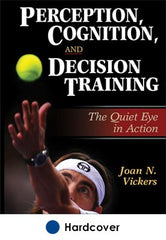Targeting may have contributed to larger brains in humans
This is an excerpt from Perception, Cognition, and Decision Training:The Quiet Eye in Act by Joan Vickers.
The ability to locate a target with the gaze and perform an aiming movement that places an object consistently on or near that target may be uniquely human. This is the thesis of William Calvin (1983),who states that humans throughout time have exhibited a fascination with targeting that is not found to the same degree in primates. Although primates may display some rudimentary targeting abilities—for example, they use rocks to open nuts or other sources of food—they never spend countless hours throwing at a far target just for the fun of it. Aiming at targets is a pursuit of many humans around the world, young and old, male and female, high and low skilled. Children will throw rocks at targets for hours, and adults continue to engage in targeting activities throughout their lifetime. Indeed, many adults make this their profession, as is the case with professional athletes in basketball, golf, ice hockey, and soccer, to name but a few sports where hitting targets with a high degree of accuracy is important.
Calvin states that aiming to hit targets led to the development of the bigger human brain. He explains that our ancestors first discovered how to hit food targets with rocks and passed this knowledge down from generation to generation. A hunter throwing at a distance is a lot safer than one close in, so special targeting implements were developed. Targeting implements evolved from those held in the hand (stones, knives), to those thrown (spears), to those propelled over great distances using bows and arrows, to rifles and missiles. A small human can fell a very large animal if the right target is hit (the heart or another vital organ) with the right implement.
As advances in targeting occurred, Calvin states that the temporal and frontal lobes developed to levels not seen in primates or other species. Of course, modern humans do not have to hunt for food, so targeting in this sense is no longer required. Instead, we have developed complex sport and computer games that stimulate and challenge the human mind to be accurate and consistent.
Humans have evolved all manner of targeting pursuits that require the placing of objects in or on specific locations, most often under difficult conditions. As mentioned, sport is one of the main arenas where this occurs. Think of the targets in golf, basketball, darts, bowling, sky diving, ski racing, kayaking through gates, hitting a receiver, playing the piano, and video games. These activities all contain targets of some kind. It often takes many years of practice to be good at a targeting activity. Furthermore, in order for a targeting skill to find a place in a sport, it has to be challenging for most humans to perform. The best field shooters in basketball hit only 50% of their field shots (or chance), the best shooters in ice hockey or soccer rarely score more than once each game, and the best golfers still take 1.8 putts each hole.
More Excerpts From Perception

Get the latest insights with regular newsletters, plus periodic product information and special insider offers.
JOIN NOW


